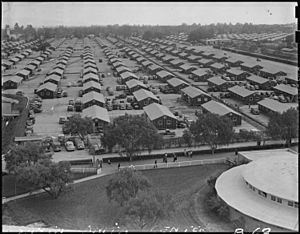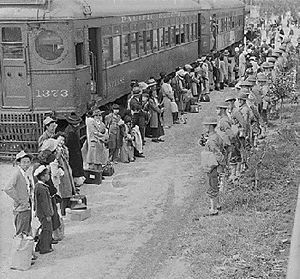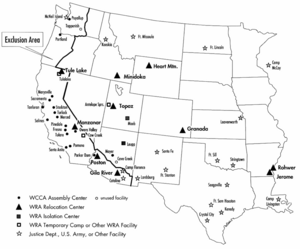Santa Anita Assembly Center facts for kids
Quick facts for kids Santa Anita Assembly Center |
|
|---|---|

Military police patrol around the Santa Anita Assembly Center in 1942
|
|
| Location | Santa Anita Racetrack |
| Built | March 27, 1942, to October 27, 1942 |
| Designated | May 13, 1980 |
| Reference no. | 934.07 |
| Lua error in Module:Location_map at line 420: attempt to index field 'wikibase' (a nil value). | |
The Santa Anita Assembly Center was a temporary place where Japanese Americans were held during World War II. It is located at what is now the Santa Anita Racetrack in Arcadia, California. This site is recognized as a California Historical Landmark (No. 934.07). It was given this special status on May 13, 1980.
Contents
Why Were Japanese Americans Held Here?
The Start of Internment Camps
After the attack on Pearl Harbor in December 1941, the United States entered World War II. Some people in the U.S. government worried about the loyalty of Japanese Americans. Because of these fears, President Franklin D. Roosevelt signed Executive Order 9066 on February 19, 1942.
This order allowed the government to create special military zones. It led to the forced relocation and detention of many people of Japanese, German, and Italian descent. Most of those affected were Japanese Americans.
Santa Anita's Role as a Detention Site
The Santa Anita Racetrack was chosen as one of these temporary detention sites. Another similar site in Los Angeles County was the Pomona Assembly Center at the Los Angeles County Fairgrounds. Both of these locations are now California Historical Landmarks. A special plaque for the Santa Anita Assembly Center can be found at the Santa Anita Racetrack entrance.
Life at Santa Anita Assembly Center
Opening and Daily Life
The Santa Anita Assembly Center opened on March 27, 1942. At its busiest, it held 18,719 Japanese Americans. People lived in different areas of the racetrack. Horse stables were turned into living spaces. About 500 new barracks, which are simple buildings, were built in the parking lot. Single men lived in the existing grandstand building.
The center was operated under military rules. A large camouflage net was placed over the detention camp. This was similar to what was done at places like the Hollywood Burbank Airport.
Closing of the Center
On August 4, 1942, a small disturbance happened at the center. The Santa Anita Assembly Center closed on October 27, 1942. Most of the people held there were then moved to more permanent camps. These permanent camps were built in more isolated areas. Some of these included Heart Mountain Relocation Center and Rohwer War Relocation Center.
More About Japanese American Internment
Temporary Facilities in California
In California, thirteen temporary detention centers were set up. These were often large places that could be easily secured. Fairgrounds, horse racing tracks, and labor camps were used. These temporary centers held Japanese Americans while larger, permanent camps were built.
Two of the permanent camps built in California were Camp Manzanar and Camp Tulelake.
The Impact of Executive Order 9066
Executive Order 9066 officially began on March 30, 1942. This order required all people of Japanese ancestry living in California to report for detention. This included both those born in America and those who were legal residents for a long time.
Japanese Americans were held in these camps until the end of World War II in 1945. In total, about 97,785 Californians of Japanese ancestry were held during the war.
Marker
A historical marker at the site explains:
- NO. 934 TEMPORARY DETENTION CAMPS FOR JAPANESE AMERICANS-SANTA ANITA ASSEMBLY CENTER AND POMONA ASSEMBLY CENTER – These temporary camps were the first step in the mass detention of 97,785 Californians of Japanese ancestry during World War II. President Franklin D. Roosevelt signed Executive Order 9066 on February 19, 1942. This led to thirteen temporary detention places being built at racetracks, fairgrounds, and labor camps in California. These places held Japanese Americans until more permanent camps, like Manzanar and Tule Lake, could be built. Starting March 30, 1942, all Americans born in the U.S. and legal residents of Japanese ancestry in California were ordered to report for detention.




